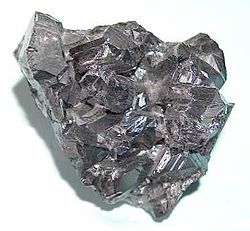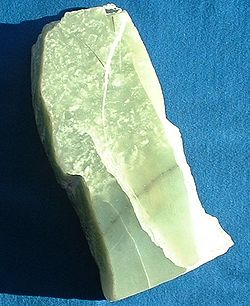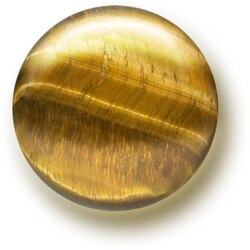Common terms

Adamantine lustre
Adamantine minerals possess a superlative[ clarification needed ] lustre, which is most notably seen in diamond. [1] Such minerals are transparent or translucent, and have a high refractive index (of 1.9 or more). [2] Minerals with a true adamantine lustre are uncommon, with examples including cerussite, zircon, and cubic zirconia. [2]
Minerals with a lesser (but still relatively high) degree of lustre are referred to as subadamantine, with some examples being garnet and corundum. [1]

Dull lustre
Dull (or earthy) minerals exhibit little to no lustre, due to coarse granulations which scatter light in all directions, approximating a Lambertian reflector. An example is kaolinite. [3] A distinction is sometimes drawn between dull minerals and earthy minerals, [4] with the latter being coarser, and having even less lustre.

Greasy lustre
Greasy minerals resemble fat or grease. A greasy lustre often occurs in minerals containing a great abundance of microscopic inclusions, with examples including opal and cordierite, jadeite. [2] Many minerals with a greasy lustre also feel greasy to the touch. [5]

Metallic lustre
Metallic (or splendent) minerals have the lustre of polished metal, and with ideal surfaces will work as a reflective surface. Examples include galena, [6] pyrite [7] and magnetite. [8]

Pearly lustre
Pearly minerals consist of thin transparent co-planar sheets. Light reflecting from these layers gives them a lustre reminiscent of pearls. [9] Such minerals possess perfect cleavage, with examples including muscovite and stilbite. [2]

Resinous lustre
Resinous minerals have the appearance of resin, chewing gum or smooth-surfaced plastic. A principal example is amber, which is a form of fossilized resin. [10]

Silky lustre
Silky minerals have a parallel arrangement of extremely fine fibres, [2] giving them a lustre reminiscent of silk. Examples include asbestos, ulexite and the satin spar variety of gypsum. A fibrous lustre is similar, but has a coarser texture.

Submetallic lustre
Submetallic minerals have similar lustre to metal, but are duller and less reflective. A submetallic lustre often occurs in near-opaque minerals with very high refractive indices, [2] such as sphalerite, cinnabar, anthracite, and cuprite.

Vitreous lustre
Vitreous minerals have the lustre of glass. (The term is derived from the Latin for glass, vitrum.) This type of lustre is one of the most commonly seen, [9] and occurs in transparent or translucent minerals with relatively low refractive indices. [2] Common examples include calcite, quartz, topaz, beryl, tourmaline and fluorite, among others.

Waxy lustre
Waxy minerals have a lustre resembling wax. Examples include jade [11] and chalcedony. [12]




